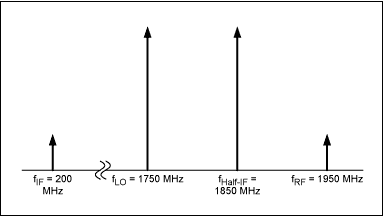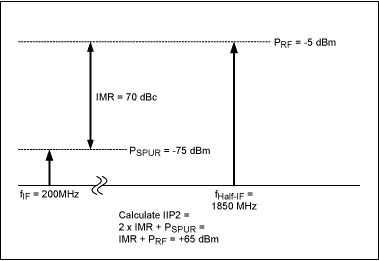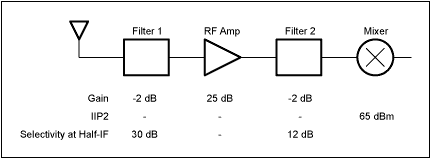| Abstract: This article describes the second-order intermodulation point (IP2) and the 2x2 spurious response in detail. These two parameters often appear in RF device specifications, such as mixers. This article helps readers to grasp the calculation method of mutual conversion between IP2 and 2x2 spurious response indicators. When the mixer data sheet provides the second-order response index in the AC electrical characteristics table, the second-order intermodulation (IP2) characteristics or 2x2 spurious response characteristics are mentioned. The purpose of this application note is to provide the relationship between these two indicators and their application in receiver design. In addition, the application of Maxim's MAX9993 active mixer in UMTS WCDMA system will be used as an example to analyze the relationship between IP2 and 2x2 spurious response. The harmonics of the mixer are in the receiving circuit. The mixer converts the higher frequency radio frequency (RF) signal to a lower frequency intermediate frequency (IF) signal. This process is called down conversion. When using the RF frequency minus this Oscillation (LO) signal frequency is called low-side injection (LO frequency is lower than RF frequency), when using LO frequency minus RF frequency is called high-side injection. This down-conversion process can be described by the following formula: fIF = ± fRF ± fLO In the above formula, fIF represents the IF signal at the output of the mixer, fRF is any RF signal added to the RF input of the mixer, and fLO represents the addition to the mixer The LO signal at the LO input of the converter. Ideally, the mixer's output signal amplitude and phase are proportional to the input signal's amplitude and phase, and this relationship is independent of the characteristics of the LO signal. (Here is compared with the multiplier. The amplitude and phase of the multiplier have no definite relationship between input and output.) Using this assumption, the amplitude response of the mixer is linear and independent of the RF input For LO input. However, the non-linearity of the mixer produces undesirable mixing products called spurs. These products are due to the undesired signal reaching the RF input port of the mixer and producing corresponding products at the IF frequency. . The trouble is that the signal entering the RF port does not necessarily fall within the desired RF band. In many cases, the power level of these signals is high, and the RF filter before the mixer cannot provide sufficient suppression to avoid additional spurious products. When these spurious products interfere with the desired IF frequency, the mixing mechanism can be expressed by the following formula: fIF = ± m fRF ± n fLO In the above formula, m and n are the integer harmonics of RF and LO, respectively. After the frequency, a large number of spurious products are generated. In fact, the amplitude of these stray products decreases with increasing m or n. After determining the frequency range to be processed, the frequencies of IF and LO should be carefully selected to avoid any possible mixing spurious products. A filter can be used to filter out RF signals that may be mixed and fall into the IF band. The filter after the mixer is used to filter out the spurious signal before the detector and only pass the required IF signal. However, spurious signals in the IF band will not be filtered by the IF filter. Various types of balanced mixers can suppress certain m and n spurious signals. An ideal double-balanced mixer can suppress all m or n (or even both) mixing products that are even-numbered. In all double-balanced mixers, IF, RF and LO are isolated from each other. Therefore, by designing a suitable single-ended to differential conversion transformer (Balun), these mixers can cover all RF, IF, and LO bands. Distribution of half-IF spurious products This application note examines a significantly more tricky second-order spurious response called half-IF (fIF / 2). In terms of mixers, when m = 2, n = -2 is called low-side injection, m = -2, n = 2 is called high-side injection. For low-side injection, the input frequency that produces half-IF spurs is lower than the required RF signal frequency by fIF / 2 (see Figure 1). The required RF frequency is 1950MHz, and after mixing with the 1750MHz LO signal, the resulting IF frequency is 200MHz. Taking this as an example, a signal at 1850MHz can produce an undesired semi-IF spurious signal at 200MHz. For high-side injection, the input frequency (fIF / 2) that produces half-IF spurs is higher than the required RF signal. The half-IF spurious response shown in Figure 1 is assumed to be low-side injection (m = 2, n = -2) and is used in UMTS WCDMA receivers. Although the WCDMA RF and IF carriers have a bandwidth of 3.84MHz, the single frequency point shown in the figure is shown as the center carrier frequency.  Figure 1. Required frequency distribution of spurious signals for fRF, fLO, fIF, and fHalf-IF Assumption: fRF = 1950MHz fLO = 1750MHz fIF = 200MHz Calculation: fHalf-IF = fRF – fIF / 2 = 1850 Proof calculation: 2 × fHalf-IF – 2 × fLO = 2 × (fRF-fIF / 2)-2 × (fRF-fIF) = 2 × fRF – 2 × fIF / 2-2 × fRF + 2 × fIF = fIF The result is: 2 × 1850MHz – 2 × 1750MHz = 200MHz The receiver ’s IP22x2 spurious response is suppressed from the mixer ’s IP2 specification Derivation. When defining the IP2 or 2x2 characteristics of a mixer, it is generally assumed that only the fundamental components of RF and LO are injected into the mixer port and that harmonic distortion is only produced by the mixer itself. The image-frequency suppression filter at the front end of the mixer in the RF channel can attenuate the harmonic components of any amplifier. The noise attenuator in the LO path can attenuate the harmonic components generated by the signal source in the LO channel. High-level injection signals will produce distortion or intermodulation products, whether at the input or output of the system or device 1, these products can be quantified by calculating the intermodulation point. The input intermodulation point is the input signal amplitude when the amplitude of the desired signal is the same as the amplitude of the undesired harmonic components. In this case, the LO input of the mixer remains constant, and the order or distortion product of the intermodulation point is determined only by the RF multiplier rather than the LO multiplier, because we only consider the distortion change of the RF signal. The amplitude of the distortion product increases with the input signal amplitude by the order of the distortion signal. For example, when the amplitude of the input signal increases by 1dB, the amplitude of the second-order intermodulation (IM) product increases by 2dB. The half-IF spurious power level can be found in the AC Electrical CharacterisiTIcs table of the MAX9993 data sheet. The RF spurious level at 1840MHz is set to -5dBm. At 1750MHz, the LO level is set to + 6dBm. The typical 2RF – 2LO spurious response measured is 70dB below the RF carrier level in dBc. The intermodulation rejection ratio (IMR) is 70dBc. The signal level in Figure 2 refers to the input mixer and is used to calculate the input IP2 or IIP2 characteristic parameters.  Figure 2. Calculation of second-order intermodulation IIP2 involving the mixer input The 2x2 spurious characteristic level can be obtained from the following formula: IIP2 = 2 × IMR + PSPUR = IMR + PRF IIP2 = 2 × 70dBc + (-75dBm) = 70dBc + (-5dBm) IIP2 = + 65dBm Similarly, Maxim's MAX9982 900MHz can provide 2dB – 2LO spurious response of 65dBc under the same conditions. The corresponding result is: IIP2 = 2 × IMR + PSPUR = IMR + PRF IIP2 = 2 × 65dBc + (-70dBm) = 65dBc + (-5dBm) IIP2 = + 60dBm UMTS WCDMA example In the UMTS WCDMA 3G design, using the 2x2 index in the MAX9993 data sheet, the equivalent IIP2 characteristic is calculated as 65dBm, as shown in Figure 2. Assume that a UMTS WCDMA cellular system coexists with a DCS1800 cellular system, resulting in a + 16dBm continuous wave blocking signal outside the band (as described in the 3GPP standard). For the UMTS WCDMA receiver, the IIP2 value at the antenna port is calculated to be approximately + 128dBm. Figure 3 is a simplified block diagram of the receiving front-end up to the first-pole mixer, showing the gain of each stage, the second-order intermodulation point, and the half-IF suppression.  Figure 3. Simplified block diagram for calculating IIP2 The overall cascade IIP2 characteristic is determined by the gain of each stage, the suppression of the filter at the half-IF position, and the 2x2 or IIP2 characteristic of the mixer. The cascaded IIP2 before the mixer decreases with the gain value of each stage on the channel (dB vs. dB). Adding additional spurious suppression at the front end of the mixer can improve RF sensitivity. The equivalent intermodulation point of the antenna port to be calculated is increased in dB by 2 times the half-IF suppression. This is because the increase rate of the second harmonic distortion amplitude is two Times. The calculation of the IIP2 indicator at the antenna port is as follows: IIP2Cascade = IIP2Mixer – gain + 2 × sensitivity = + 128dBm IIP2Cascade = 65 – (-2 +25 –2) + 2 × (30 +12) = + 128dBm It can be clearly seen that in order to meet the half-IF spurious response, the high IIP2 characteristic of MAX9993 can reduce the requirements for filter suppression . For example, if the IIP2 of the mixer is reduced from + 65dBm to + 45dBm, the suppression of the cascade filter must be increased by 10dB. Conclusion After reading this application note, the reader should be able to derive the 2x2 spurious response of the mixer and its corresponding IIP2 specification. This level of understanding of the second-order relationship allows engineers to determine the proper mixer characteristics in the application to be performed. The MAX9993 2GHz mixer and the MAX9982 900MHz mixer provide excellent 2x2 (IP2) characteristics, thereby reducing the requirements for filters and making the design of high-performance wireless systems more perfect. References CDMA Mobile Radio Design by John B. Groe, Lawrence E. Larson, published by Artech House Publishers, 2000. RF and Microwave Circuit Design for Wireless CommunicaTIons, by Lawrence E. Larson, published by Artech House Publishers, 1997. RF Design Guide Systems, Circuits, and EquaTIons by Peter Vizmuller, published by Artech House, 1995. Understanding and Enhancing SensiTIvity in Receivers for Wireless Applications, Technical Brief SWRA030, Texas Instruments, Edited by Matt Loy, May 1999. 3G TS 25.141, 3rd Generation Partnership Project; Technical Specification Group Radio Access Networks; Base station conformance testing (FDD), Release 1999. Note The output intermodulation point is the input intermodulation point obtained by the system or circuit measurement plus the gain ( In dB). |
the power Connectors we provide overmolding solutions and modular tooling.
We also offer to the OEM and distributor users a diversified line of strain / flex reliefs and grommets, such as Solid, Solid-Rib, Uniflex, Multiflex, in standard off the shelf or custom designs.
Overmolding the power connectors offers significant opportunities for cable improvements with higher pull strength not available with conventional backshells. Our technical staff is ready to help you from design and prototyping to small production run, assistance, and training.
Our team is ready to help with any of the following power connectors projects: overmolding mini fit jr. and mini-fit sr. connectors, , overmolded cables with micro fit terminations, sabre molded cable asemblies, amp duac overmolded power connectors, mate-n-lock power cables, power connector overmolding services, power connector molding, design and prototype of power cables across the board, small run molded power connecotrs , molded cable manufacturing, overmolding connectors for any power applications
Strain/flex Reliefs And Grommets
Strain Reliefs And Grommets,Flex Reliefs And Grommets,Cable Strain Reliefs,Cable Flex Reliefs,Cable Grommets,Molded Strain Relief
ETOP WIREHARNESS LIMITED , https://www.etopwireharness.com